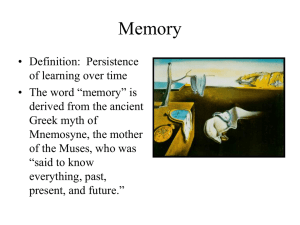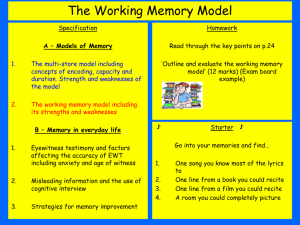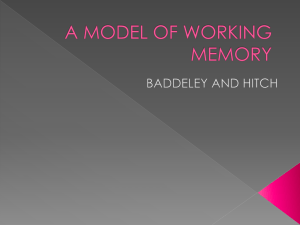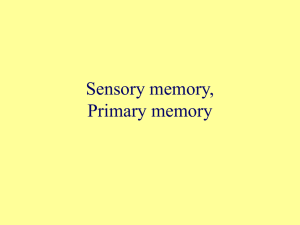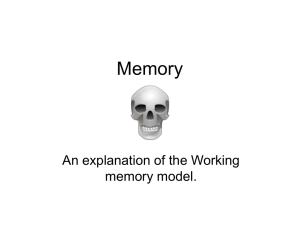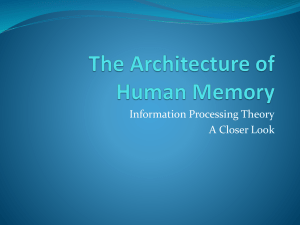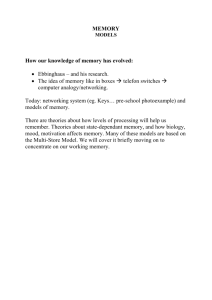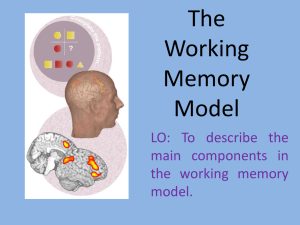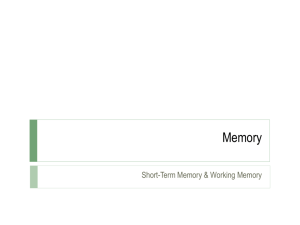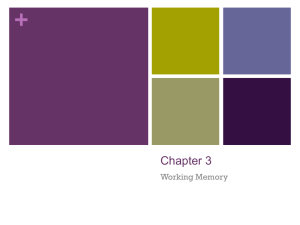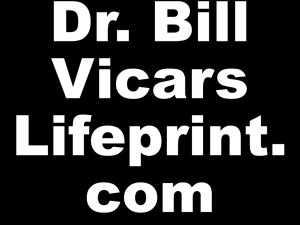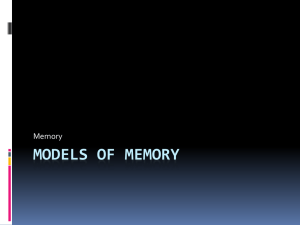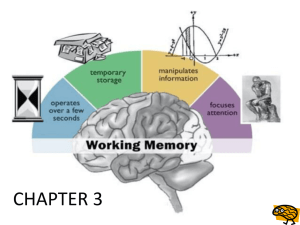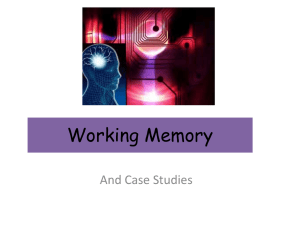Working memory theory was introduced by Baddeley
advertisement
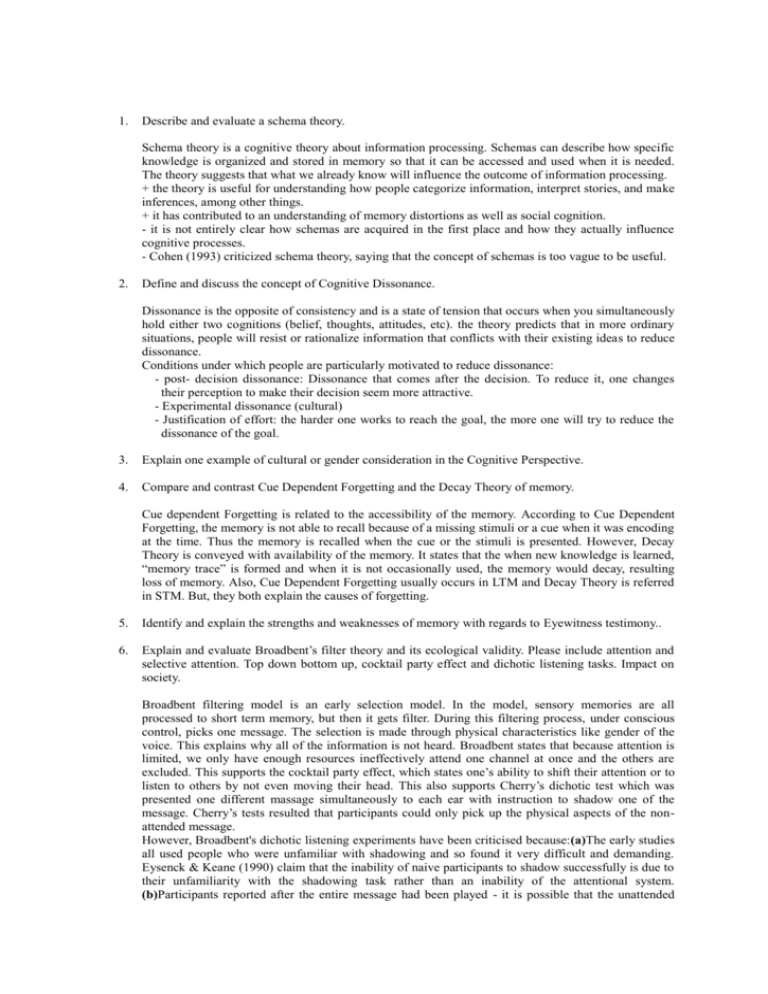
1. Describe and evaluate a schema theory. Schema theory is a cognitive theory about information processing. Schemas can describe how specific knowledge is organized and stored in memory so that it can be accessed and used when it is needed. The theory suggests that what we already know will influence the outcome of information processing. + the theory is useful for understanding how people categorize information, interpret stories, and make inferences, among other things. + it has contributed to an understanding of memory distortions as well as social cognition. - it is not entirely clear how schemas are acquired in the first place and how they actually influence cognitive processes. - Cohen (1993) criticized schema theory, saying that the concept of schemas is too vague to be useful. 2. Define and discuss the concept of Cognitive Dissonance. Dissonance is the opposite of consistency and is a state of tension that occurs when you simultaneously hold either two cognitions (belief, thoughts, attitudes, etc). the theory predicts that in more ordinary situations, people will resist or rationalize information that conflicts with their existing ideas to reduce dissonance. Conditions under which people are particularly motivated to reduce dissonance: - post- decision dissonance: Dissonance that comes after the decision. To reduce it, one changes their perception to make their decision seem more attractive. - Experimental dissonance (cultural) - Justification of effort: the harder one works to reach the goal, the more one will try to reduce the dissonance of the goal. 3. Explain one example of cultural or gender consideration in the Cognitive Perspective. 4. Compare and contrast Cue Dependent Forgetting and the Decay Theory of memory. Cue dependent Forgetting is related to the accessibility of the memory. According to Cue Dependent Forgetting, the memory is not able to recall because of a missing stimuli or a cue when it was encoding at the time. Thus the memory is recalled when the cue or the stimuli is presented. However, Decay Theory is conveyed with availability of the memory. It states that the when new knowledge is learned, “memory trace” is formed and when it is not occasionally used, the memory would decay, resulting loss of memory. Also, Cue Dependent Forgetting usually occurs in LTM and Decay Theory is referred in STM. But, they both explain the causes of forgetting. 5. Identify and explain the strengths and weaknesses of memory with regards to Eyewitness testimony.. 6. Explain and evaluate Broadbent’s filter theory and its ecological validity. Please include attention and selective attention. Top down bottom up, cocktail party effect and dichotic listening tasks. Impact on society. Broadbent filtering model is an early selection model. In the model, sensory memories are all processed to short term memory, but then it gets filter. During this filtering process, under conscious control, picks one message. The selection is made through physical characteristics like gender of the voice. This explains why all of the information is not heard. Broadbent states that because attention is limited, we only have enough resources ineffectively attend one channel at once and the others are excluded. This supports the cocktail party effect, which states one’s ability to shift their attention or to listen to others by not even moving their head. This also supports Cherry’s dichotic test which was presented one different massage simultaneously to each ear with instruction to shadow one of the message. Cherry’s tests resulted that participants could only pick up the physical aspects of the nonattended message. However, Broadbent's dichotic listening experiments have been criticised because:(a)The early studies all used people who were unfamiliar with shadowing and so found it very difficult and demanding. Eysenck & Keane (1990) claim that the inability of naive participants to shadow successfully is due to their unfamiliarity with the shadowing task rather than an inability of the attentional system. (b)Participants reported after the entire message had been played - it is possible that the unattended message is analyzed thoroughly but participants forget. (c)Analysis of the unattended message might occur below the level of conscious awareness. For example, research by von Wright et al (1975) indicated analysis of the unattended message in a shadowing task. A word was first presented to participants with a mild electric shock. When the same word was later presented to the unattended channel, participants registered an increase in GSR (indicative of emotional arousal and analysis of the word in the unattended channel). 7. Explain the information processing model and its significance in the Cognitive perspective. The information processing model show the cognitive process occurring in the order of input, information processing, and output. This is significant in cognitive perspective because it supports that there is actions between the input and the output. Information processing model is the basic model of cognitive perspective. 8. Describe and evaluate working memory. Theories, people, studies, description, and impact on society. Working memory theory was introduced by Baddeley and Hitch in 1974. It is the explanation of how STM works. Working Memory (Baddeley and Hitch, 1974) Atkinson’s and Shiffrin’s (1968) multi-store model was extremely successful in terms of the amount of research it generated. However, as a result of this research, it became apparent that there were a number of problems with their ideas concerning the characteristics of short-term memory. Building on this research, Baddeley and Hitch (1974) developed an alternative model of short-term memory which they called working memory’ Baddeley and Hitch (1974) argue that the picture of short-term memory (STM) provided by the Multi-Store Model is far too simple. According to the Multi-Store Model, STM holds limited amounts of information for short periods of time with relatively little processing. It is a unitary system. This means it is a single system (or store) without any subsystems. Working Memory is not a unitary store. Working memory is STM. Instead of all information going into one single store, there are different systems for different types of information. Working memory consists of a central executive which controls and co-ordinates the operation of two subsystems: the phonological loop and the visuo-spatial sketchpad. Central Executive: Drives the whole system (e.g. the boss of working memory) and allocates data to the subsystems (VSS & PL). It also deals with cognitive tasks such as mental arithmetic and problem solving. Visuo-Spatial Sketch Pad (inner eye): Stores and processes information in a visual or spatial form. The VSS is used for navigation. The phonological loop is the part of working memory that deals with spoken and written material. It can be used to remember a phone number. It consists of two parts o Phonological Store (inner ear) – Linked to speech perception Holds information in speech-based form (i.e. spoken words) for 1-2 seconds. o Articulatory control process (inner voice) – Linked to speech production. Used to rehearse and store verbal information from the phonological store. The labels given to the components of the working memory reflect their function and the type of information they process and manipulate. The phonological loopis assumed to be responsible for the manipulation of speech based information, whereas the visuo-spatial sketchpad is assumed to by responsible for manipulating visual images. The model proposes that every component of working memory has a limited capacity, and also that the components are relatively independent of each other. Empirical Evidence for the Working Memory Model What evidence is there that working memory exists, that it is made up of a number of parts, that it performs a number of different tasks? The working memory model makes the following two predictions: 1. If two tasks make use of the same component (of working memory), they cannot be performed successfully together. 2. If two tasks make use of different components, it should be possible to perform them as well as together as separately. Key Study: Baddeley and Hitch (1976) Aim: To investigate if participants can use different parts of working memory at the same time. Method: Conducted an experiment in which participants were asked to perform two tasks at the same time (dual task technique) - a digit span task which required them to repeat a list of numbers, and a verbal reasoning task which required them to answer true or false to various questions (e.g. B is followed by A?). Results: As the number of digits increased in the digit span tasks, participants took longer to answer the reasoning questions, but not much longer - only fractions of a second. And, they didn't make any more errors in the verbal reasoning tasks as the number of digits increased. Conclusion: The verbal reasoning task made use of the central executive and the digit span task made use of the phonological loop. The Central Executive The central executive is the most important component of the model, although little is known about how it functions. It is responsible for monitoring and coordinating the operation of the slave systems (i.e. visuo-spatial sketch pad and phonological loop) and relates them to LTM. The central executive decides which information is attended to and which parts of the working memory to send that information to be dealt with. The central executive decides what working memory pays attention to. For example, two activities sometimes come into conflict such as driving a car and talking. Rather than hitting a cyclist who is wobbling all over the road, it is preferable to stop talking and concentrate on driving. The central executive directs attention and gives priority to particular activities. The central executive is the most versatile and important component of the working memory system. However, despite its importance in the working-memory model, we know considerably less about this component than the two subsystems it controls. Baddeley suggests that the central executive acts more like a system which controls attentional processes rather than as a memory store. This is unlike the phonological loop and the visuo-spatial sketchpad, which are specialized storage systems. The central executive enables the working memory system to selectively attend to some stimuli and ignore others. Baddeley (1986, 1999) uses the metaphor of a company boss to describe the way in which the central executive operates. The company boss makes decisions about which issues deserve attention and which should be ignored. They also select strategies for dealing with problems, but like any person in the company, the boss can only do a limited number of things at the same time. The boss of a company will collect information from a number of different sources. If we continue applying this metaphor, then we can see the central executive in working memory integrating (i.e. combining) information from two assistants (the phonological loop and the visuospatial sketchpad) and also drawing on information held in a large database (long-term memory). The Phonological Loop The phonological loop is the part of working memory that deals with spoken and written material. It consists of two parts (see Figure 3). The phonological store (linked to speech perception) acts as an inner ear and holds information in speech-based form (i.e. spoken words) for 1-2 seconds. Spoken words enter the store directly. Written words must first be converted into an articulatory (spoken) code before they can enter the phonological store. The articulatory control process (linked to speech production) acts like an inner voice rehearsing information from the phonological store. It circulates information round and round like a tape loop. This is how we remember a telephone number we have just heard. As long as we keep repeating it, we can retain the information in working memory. The articulatory control process also converts written material into an articulatory code and transfers it to the phonological store. The Visuo-Spatial Sketchpad The visuo-spatial sketchpad (inner eye) deals with visual and spatial information. Visual information refers to what things look like. It is likely that the visuo-spatial sketchpad plays an important role in helping us keep track of where we are in relation to other objects as we move through our environment (Baddeley, 1997). As we move around, our position in relation to objects is constantly changing and it is important that we can update this information. For example, being aware of where we are in relation to desks, chairs and tables when we are walking around a classroom means that we don't bump into things too often! The sketchpad also displays and manipulates visual and spatial information held in long-term memory. For example, the spatial layout of your house is held in LTM. Try answering this question: How many windows are there in the front of your house? You probably find yourself picturing the front of your house and counting the windows. An image has been retrieved from LTM and pictured on the sketchpad. Evidence suggests that working memory uses two different systems for dealing with visual and verbal information. A visual processing task and a verbal processing task can be performed at the same time. It is more difficult to perform two visual tasks at the same time because they interfere with each other and performance is reduced. The same applies to performing two verbal tasks at the same time. This supports the view that the phonological loop and the sketchpad are separate systems within working memory. Evaluation of Working Memory Strengths Researchers today generally agree that short-term memory is made up of a number of components or subsystems. The working memory model has replaced the idea of a unitary (one part) STM as suggested by the multistore model. The working memory model explains a lot more than the multistore model. It makes sense of a range of tasks verbal reasoning, comprehension, reading, problem solving and visual and spatial processing. And the model is supported by considerable experimental evidence. The working memory applies to real life tasks: –reading (phonological loop) –problem solving (central executive) –navigation (visual and spatial processing) The KF Case Study supports the Working Memory Model. KF suffered brain damage from a motorcycle accident that damaged his short-term memory. KF's impairment was mainly for verbal information - his memory for visual information was largely unaffected. This shows that there are separate STM components for visual information (VSS) and verbal information (phonological loop). Working memory is supported by dual task studies (Baddeley and Hitch, 1976). The working memory model does not over emphasise the importance of rehearsal for STM retention, in contrast to the multi-store model. Weaknesses Lieberman criticises the working memory model as the visuo-spatial sketchpad (VSS) implies that all spatial information was first visual (they are linked). However, Lieberman points out that blind people have excellent spatial awareness although they have never had any visual information. Lieberman argues that the VSS should be separated into two different components: one for visual information and one for spatial. There is little direct evidence for how the central executive works and what it does. The capacity of the central executive has never been measured. Working memory only involves STM so it is not a comprehensive model of memory (as it does not include SM or LTM). The working memory model does not explain changes in processing ability that occur as the result of practice or time.
